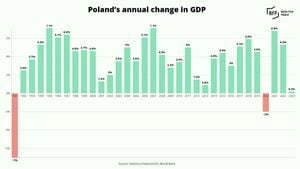New research sheds light on the half-precession cycles of ocean temperatures observed in the western equatorial Pacific (WEP), areas known for their significant contributions to global climate patterns. Using extensive climatic simulations and historical temperature reconstructions, scientists have identified these unique ~10-kyr cycles as they pulse through subsurface water masses, evoking connections between equatorial insolation and broader climate dynamics.
The study reveals the temperature variations across the WEP are not merely random fluctuations; they reflect complex interactions determined by various forms of solar radiation and local ocean currents. Particularly, maximum equatorial insolation affects surface and upper subsurface temperatures, whereas lower subsurface temperatures are influenced by bi-hemisphere maximum insolation.
Research focused on climate data spanning the last 800,000 years and highlighted the importance of the WEP as part of the largest reservoir of warm water on Earth. This vast water body not only plays an integral role in global heat redistribution but also serves as the fulcrum for the Hadley and Walker atmospheric circulations, impacting life far from the tropics.
Though significant steps have been made to understand climate variability here, there is still much to explore concerning the temperature variability and its underlying forcing mechanisms. Previous studies have documented longer cycles, yet the half-precession signal remains less examined, imbuing this research with its importance.
The team analyzed five sediment cores from the WEP, employing transient climate simulations based on data gleaned from high-resolution reconstructions. The results demonstrated the existence of these strong half-precession cycles throughout various ocean depths, strengthening over time but markedly influenced by local conditions.
Interestingly, the interactions observed have revealed different influences on temperatures across the depths modeled. For example, at the 163-meter mark, ocean temperatures showed correlations with hemispheric insolation gradients, attributing the half-precession cycles' emergence to more substantial dynamics at play within the subtropical waters.
Reflecting on the findings, the authors of the article stated, "The half-precession signal observed may contribute to the half-precession dynamics recorded globally from various climatic proxies, emphasizing how these isolated oceanic currents tether back to linked climate systems worldwide."
What is especially intriguing is the role of greenhouse gases and resulting ice sheets on modulating these ocean temperatures. The study's simulations indicated the effects of greenhouse gases could significantly amplify the longer-term cycles over the half-precession signal, spotlighting the need for future work to tease apart these influences.
The authors concluded by cautioning against viewing these cycles as isolated, asserting, "The modulation by greenhouse gases and ice sheets indicates complex interplay affecting the dynamics of the WEP temperature cycles. With important regional and global repercussions, our findings signal potential future directions for climate research focusing on these pivotal climatic markers."
This study not only enhances the comprehension of WEP temperature variations but also lays the groundwork for future inquiries, advocating for more detailed examination of how half-precession cycles inform the dialogue on climate variability and global change.



